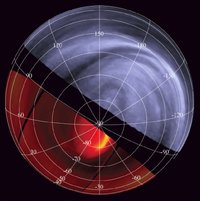The VVEx data service provides access to the VIRTIS / Venus-Express dataset with detailed description of each observation. Calibrated files are described by a variety of parameters retrieved from the PI team database, and are linked to ESA’s Planetary Science Archive (PSA). The detailed description allows for accurate searches in the dataset.
The VIRTIS instrument
The optical and infrared spectrometer VIRTIS was originally developed for the Rosetta mission. When the Venus-Express mission was designed, the spare model of VIRTIS was proposed and selected for the scientific payload. The instrument results from a collaboration between Italy (IAPS/INAF providing the mapping channel VIRTIS-M), France (LESIA providing the high-resolution channel VIRTIS-H) and Germany (DLR providing the electronics and on-board sotfware).

The instrument was composed of two imaging spectrometers (M-vis and M-IR, 0.4-5 µm) and an echelle spectrometer providing 10x higher resolution in a single pixel (VIRTIS-H, 2-5 µm). VIRTIS operated in Venus orbit from June 2006 to October 2014, until the end of mission; the two IR channels stopped operations in 2011 at the end of cryocoolers lifetime. The dataset is distributed on ESA’s Planetary Science Archive (PSA) in PDS3 format.
- Piccioni et al, 2007: VIRTIS: The Visible and Infrared Thermal Imaging Spectrometer, ESA SP 1295.
- Drossart et al, 2007: Scientific goals for the observation of Venus by VIRTIS on ESA/Venus Express mission. PSS 55, 1653-72; 10.1016/j.pss.2007.01.003
Virtual Observatory service
A Virtual Observatory (VO) data service has been setup to provide easier access to the dataset.
Calibrated and geometry files (not raw data) are included for the whole mission except the cruise phase. Files are described with the most relevant parameters from the PI team database, including observing modes, location on planet, and illumination conditions. Files can be searched and selected based on these parameters. Selected thumbnails are provided for the two M channels.
This data service is responsive to the EPN-TAP data access protocol, and can be queried from the VESPA portal of Solar System data: https://vespa.obspm.fr/
See the complete data service in VESPA (the schema name is vvex).
Future prospects include the addition of derived products (maps, profiles, etc) from publications. Direct access to individual spectra with description is being evaluated. The use of a more handy data format (fits with embedded geometry) is also under study.
Searching for data files
Important search parameters include:
c1 / c2 – longitude and latitude of the FOV projected at the surface, with min and max values (bounding box for cubes) – the detailed footprint is also provided in MOC format under coverage, see below
incidence, emergence, phase – illumination angles on the surface
target_distance_min / max – measured along the line of sight (= PDS’ slant distance), related to spatial resolution
solar_longitude_min / max – provides the season (= Ls)
local_time_min / max – provides local time at surface
time_min / max – time of acquisition (UTC, provided in Julian Days)
RA, Dec – sky coordinates, provided for inertial pointing mode
target_name – standard name of the objet, IAU spelling (a few observations are not related to Venus)
spectral_range_min / spectral_range_max – limits of the spectral range (given in Hz in the table)
spectral_sampling_step_min / spectral_sampling_step_max – accounts for binning mode
time_exp_min / time_exp_max – global integration time , including on-board summing
measurement_type – measured quantity provided as a UCD (all data are calibrated in radiance)
sun_distance – controls the heating of atmosphere; required to calibrate in reflectance
science_case_id – relates to spacecraft operations
sc_pointing_mode – provides pointing mode, related to science cases
channel_id – identifies the 3 VIRTIS channels
granule_gid – a tag to distinguish calibrated data from geometry files
Displaying spectral cubes
The result of a selection in the VESPA portal can be sent to various VO tools for analysis. However, PDS3 spectral cubes are notoriously difficult to read.
• For on-line quicklook, APERICubes will receive data sent as “VIRTIS PDS cubes” from the portal. It will extract images and spectra, and can send the results in fits format to specialized tools (CASSIS or SPLAT-VO for spectra, Aladin or ds9 for images).
• For detailed analysis, the team software accesses the data under IDL and its open source clone GDL – this is a versatile PDS3 library with special support for VIRTIS files.
Metadata are more easily handled, and can be sent to VO tools from the portal:
• TOPCAT will receive metadata sent as table, to display all sort of parameters, including footprints.
• Mizar can display bounding boxes (C1/C2 parameters) in real time.
• Aladin can display footprints (“coverage” parameter) on Venus maps.
Cube footprints are provided in MOC format in the “coverage” parameter. Footprints include only spectra intercepting the cloud layer (at 60 km) and are provided on top of this layer (i.e., pixels pointing above the clouds are not included in the footprints); beware that these MOC are limited in resolution and may look discontinued in some cases, in particular for H sessions. MOC can be used for 2D searches in tools such as Aladin or the VESPA geoportal.
A tutorial is available to illustrate data handling of VVEx cubes in VO tools.
Access to VIRTIS VEx data and documentation
• The VIRTIS Venus-Express data are distributed on ESA’s Planetary Science Archive (PSA) which has both a search interface and direct access through https (called ftp access for historical reasons). It provides full access to the dataset, including raw data files, ancillary files (complete set of browse images, calibration files, instrument Spice kernels, etc) and documentation (catalogues, etc). Mission Spice kernels are available on another ftp server as described here.
• The PSA as a whole also has an EPN-TAP interface which allows for cross-searches between datasets. Data description and search parameters are common to all files in the PSA, and are less detailed than on the VVEx service.
• The VEx mission catalog describes operations, events, and science goals during the course of the mission (this is the latest version, dated May 2015).
• The VIRTIS archive document (EAICD) provides essential information about the instrument and dataset (other docs are included in the PSA archive).
• A hands-on manual to manipulate VIRTIS data has been produced for an ESA workshop in 2014. This goes with a tutorial and solutions.
Contact the helpdesk for comments: support.vespa@obspm.fr
_____________________
This data service is provided in the framework of the VESPA activity in Europlanet-2020 and Europlanet-2024 by Paris Astronomical Data Centre (PADC).
The Europlanet 2020 and Europlanet 2024 Research Infrastructure projects have received funding from the European Union’s Horizon 2020 research and innovation programme under grant agreements No 654208 & No 871149. Additional support was provided in France by the Action Spécifique Observatoire Virtuel and Programme National de Planétologie / INSU.


